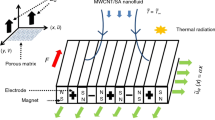Abstract
Most of the numerical methods used for shallow water flow calculation are not applicable to the numerical calculation of the discontinuous flows. High precision resolution is a difficult problem in simulate discontinuous flows. This paper adopts Roe scheme approximate Riemann solver to deal with normal vector through interface, apply TVD–MUSCL scheme and Hancock scheme to increase the precision of space and time to second order using in tidal bore simulation. In order to verify the accuracy of the model and simulate the ability of discontinuous flows, some numerical examples are simulated in this paper, the results of simulation and other scholars’ results are compared to check the applicability and accuracy of the model for discontinuous flow. With the generalized river course tidal bore experiment to prove the model has the ability to capturing shock wave and better calculative precision.







Similar content being viewed by others
References
Li, X. S., & Li, X. L. (2016). All-speed Roe scheme for the large eddy simulation of homogeneous decaying turbulence. International Journal of Computational Fluid Dynamics, 30(1), 69–78.
Zingale, M., & Katz, M. P. (2015). On the piecewise parabolic method for compressible flow with Stellar equations of state. Astrophysical Journal Supplement, 216(2), 1–30.
Kumar, S., & Singh, P. (2015). Higher-order MUSCL scheme for transport equation originating in a neuronal model. Oxford: Pergamon Press Inc.
Delis, A. I., & Skeels, C. P. (2015). TVD schemes for open channel flow. International Journal for Numerical Methods in Fluids, 26(7), 791–809.
Rumsey, C. L., Gatski, T. B., Iii, W. L. S., et al. (2015). Summary of the 2004 computational fluid dynamics validation workshop on synthetic jets. AIAA Journal, 44(2), 194–207.
Acknowledgements
The authors acknowledge the Natural Science Foundation of the Inner Mongolia Autonomous Region (2017BS0105).
Author information
Authors and Affiliations
Corresponding author
Rights and permissions
About this article
Cite this article
Sun, D. TVD–MUSCL Finite Volume Model Using in Tidal Bore Simulation Research. Wireless Pers Commun 102, 1751–1761 (2018). https://doi.org/10.1007/s11277-017-5233-9
Published:
Issue Date:
DOI: https://doi.org/10.1007/s11277-017-5233-9




